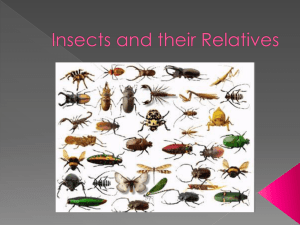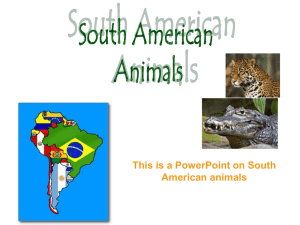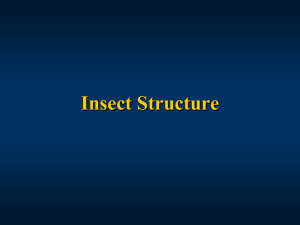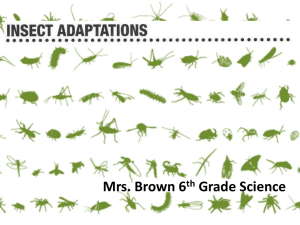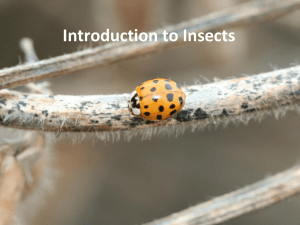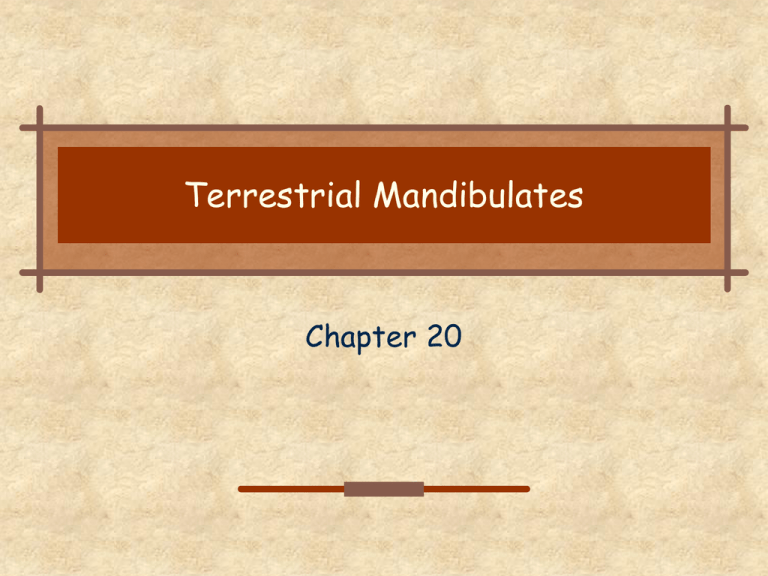
Terrestrial Mandibulates
Chapter 20
I. Characteristics of Subphylum
Uniramia
Body tagmata: head,
thorax, abdomen
1 pair of antenna;
appendages
uniramous
Primarily terrestrial
II. Class Chilopoda A. Characteristics
Found under logs, bark,
and stones
Carnivorous, eating
earthworms,
cockroaches, and other
insects
House centipede has 15
pairs of long legs
Most are harmless but
some tropical ones are
dangerous
B. Body Structure
Flattened bodies with up to 177 somites
1st body segment has poisonous claws
Head: 1 pair antennae, 1 pair mandibles, 1-2
pairs maxillae
Eyes on sides of head are groups of ocelli
Separate sexes
Some lay eggs; some viviparous
Young resemble small adults
III. Class Diplopoda A. Characteristics
Less active than
centipedes
Eat decayed plants; a
few eat living plants
Slow moving; roll into a
coil for defense
Some secrete toxic or
repellant substances
from special glands on
side of body
B. Body Structure
2 pairs of legs per
somite
Bodies have 25-100
somites
Head: 2 clusters of
simples eyes, 1 pair of
antennae, mandibles,
and maxillae
Female lays eggs in nest
and guards them
Larvae have only 1 pair
of legs per somite
IV. Class Insecta A. Diversity
Most diverse and
abundant of all
arthropods
Estimated at 1 million
species
Found in nearly all
habitats except sea
Most animals and plants
have insect parasites
externally and internally
Range in size from 1 mm
to 20 cm; tropical
insects tend to be larger
B. Adaptability
Flight and small size makes insects widely
distributed
Well-protected eggs can withstand rigorous
conditions and are easily dispersed
Structural and behavioral adaptations give
them access to many possible niches
Some insects are adapted to coexist with one
plant species
Exoskeletons allows for desert survival
C. External Form & Function 1. Head
1 pair of large
compound eyes
1 pair of antennae;
vary greatly in form;
feel, taste, and hear
Mouthparts: labrum,
pair of mandibles
and maxillae, a
labium, an a
hypopharynx
Insect Heads
2. Thorax
Prothorax, mesothorax,
metathorax; each has a pair of
legs
Mesothorax and metathorax
each have wings
Wings have double membrane
with veins (strengthens and
identifies insects)
Legs end in terminal pads and
claws
Some legs are modified for
special purposes: hindlegs of
grasshopper for jumping;
forelegs of preying mantis for
grasping prey; honeybee legs
for collecting pollen
Insect Legs
3. Abdomen
9-11 segments ending in a pair of cerci
Larval or nymph forms may have appendages not in
adults
External genitalia at end of abdomen
D. Flight 1. Wings
Outgrowth of cuticle from meso- and
metathoracic segments
Diptera (flies) have only one pair; rest have
2; flies have halteres (knobby reduced wings)
that provide balance
Lice, fleas, and nonreproductive ants and
termites are wingless
Wings for flight are thin and membranous;
thick horny front ones of beetle are
protective; butterflies have scales on wings
Insect Wings
2. Muscles
Direct flight muscles attach to wing
Indirect flight muscle changes shape of
thorax which then moves wings
Dragonflies and cockroaches use direct
muscles to fly
Bees, wasps, and flies move indirect muscles
Beetles and grasshoppers use combination
Wings move in figure-8
Wing beats vary from 4/second (butterflies)
to over 1000/second (midges)
E. Internal Form and Function
1. Digestive System
Mouth seizes and crushes food; salivary
glands to aid in digestion; some insects have
sucking mouthparts; flies have lobes that
absorb food
Gizzard grinds food; midgut digests and
absorbs food; hindgut absorbs water
Most insects feed on plant tissue or juices
Some ants and termites cultivate fungus
gardens
Some insects are predators or are parasites
(hyperparasites parasitize parasitic insects)
2. Circulatory System
Tubular heart moves
hemolymph through
dorsal aorta
Heartbeat peristalic
wave
Accessory organs move
hemolymph into wings and
legs
Hemolymph has plasma
and amebocytes but does
not use oxygen transport
3. Respiratory System
Tracheal system a
network of thin tubes
branched throughout
insects body
Spiracles open to
trachea; 2 on thorax
and 7-8 on abdomen
Valve on spiracle
prevents water loss and
acts as dust filter
Tracheae branch into
fluid filled tracheoles
that reach individual
body cells allowing gas
exchange
4. Excretion
Malpighian tubules excrete uric acid
Rectal glands reabsorb chloride, sodium, and
water allowing other wastes to be excreted
5. Nervous System
Fused ganglia
Neurosecretory cells in brain control molting
and metamorphosis
6. Sense Organs a. Mechanoreception
Touch, pressure, and
vibration are picked
up by sensilla ( single
hair-like seta or
organ)
Sensilla on antennae,
legs, and body
b. Auditory Reception
Sensilla or tympanal
organs may detect
airbourne sounds
Organs found on
Orthoptera,
Homoptera, and
Lepidoptera
Organs in legs can
detect vibrations on
ground
C. Visual Reception
Ocelli monitor light intensity
but do not form images
Compound eyes have ommatidia
like crustaceans
See simultaneously in almost
all directions; image is myopic
and fuzzy
Flying insects can process
200-300 image flashes per
second
Bees use UV light but can not
see red
D. Chemoreception & Other Senses
Sensory cells located in
sensory pits located on
mouthparts, antennae,
and legs
Can detect some odors
kilometers away
Feeding, mating, habitat
selection, host selection
all done though use of
chemoreceptors
Cells on legs and
antennae detect
temperature changes,
humidity, and gravity
7. Muscular System
Muscles are cross-striated
Strength of muscle is related to crosssectional area
F. Reproduction
Sexes are separate
Some insects use phermones,
light, sound, color signals,
courtship behaviors as
attractant
Sperm deposited in vagina
during fertilization
May lay a few eggs and care
for young or lay many eggs
Eggs laid on host plant or
animal
G. Metamorphosis and Growth
Most insects change
form after hatching
from egg
Each stage between
molts is called an
instar
Wings develop
during last stage
when useful during
reproduction
1. Homometabolous
88% of insects
Egg, larval growth (may
have several instars),
pupal differentiation,
adult reproduction
Pupa usually formed
over winter, adult
emerging in spring
2. Hemimetabolous
Gradual metamorphosis
Grasshoppers, cicadas,
mantids, true bugs,
mayflies, dragonflies
Young are called nymphs
Egg, nymph, adult
3. Direct Development
Young similar to
adults just
smaller in size
Silverfish and
springtails,
primarily
wingless insects
Egg, juvenile,
adult
4. Physiology of Metamorphosis
Regulated by hormones produced by brain and
ganglia
Molting hormone produced in response
Molting continues as long as juvenile hormone
produced
With each instar, less and less juvenile
hormone produced, until 0 is produced and
adult emerges
Adults do not molt
H. Diapause
Period of dormancy in life cycle independent
of conditions; genetically determined but may
be triggered by environmental cues
Usually active growth triggers diapause
Winter dormancy—hibernation
Summer dormancy—estivation
Any life stage may become dormant to
survive adverse conditions
I. Defense
Protective coloration, warning coloration, mimicry are
protective adaptations
Also repulsive odors and tastes (stink bugs) or may
spray irritating chemicals (bombardier beetle)
Some are aggressive (bees and ants)
J. Behavior and Communication
Well developed senses lead insects to
respond to many stimuli
Most behavior is innate but some is learned
1. Phermones
Chemicals secreted by one
individual to affect
behavior of another
individual
Attract opposite sex,
trigger swarming, fend off
aggression, and mark trails
Bees, wasps, ants
recognize nestmates and
trigger alarms in response
to invaders
Phermones used to attract
and trap insects
2. Sound Production & Reception
Sounds used as warnings, announcing
territory, and courtship songs
Sounds may be made by chirps or rubbing of
body parts
3. Tactile Communication
Tapping, rubbing,
grasping, and antennae
touching
Bioluminescence
4. Social Behavior
True societies as demonstrated by bees, termites,
and ants have developed a complex social life as a
means to perpetuate their species.
The societies exhibit a caste system which involves
all stages in the life cycle, involve complex
communication, and division of labor.
Honey bees have 3 castes: queen (single sexually
mature female), drones (few hundred sexually mature
males), and workers (thousands of sexually inactive
females).
Termites and ants have several fertile males (kings)
and females (queens); sterile individuals are workers
and soldiers. Soldiers have larger heads and
mandibles for defense.
Paper Wasps
Honey Bee Waggle Dance
Queen ant and male
K. Insects and Humans
1 & 2 Beneficial/Harmful Insects
Insects produce products that humans utilize
like honey, beeswax, silk, shellac
Insects also pollinate $10 billion dollars
worth of human food crops in the US.
Some insects prey on other insects humans
consider pests.
Some insects are agricultural/horticultural
pests
Other insects transmit diseases, parasitize
humans, or destroy property.
3. Control of Insects
Insect play an important role in the food web since
they are food sources for many organisms and their
removal would have a cataclysmic effect.
Control of insects through insecticides has a lasting
effect on the environment since many insecticides
accumulate in the body tissues of larger organisms,
eventually harming them as well.
Biological controls utilize other predatory insects,
toxic strains of bacteria or viruses, engineering
plants with toxins, releasing sterile males, or altering
reproduction rates through the use of hormones.
Orthoptera
(grasshoppers, crickets,
katydids, and
cockroaches)
Isoptera (termites)
Dermaptera (earwigs)
Anoplura (sucking lice)
Hemiptera ("true" bugs)
Homoptera (aphids,
mealy bugs, and cicadas)
Ephemeroptera (mayflies)
Odonata (dragonflies and
damselflies)
Neuroptera (dobsonflies and
lacewings)
Coleoptera (weevils,
ladybugs, and beetles)
Lepidoptera (butterflies and
moths)
Diptera (mosquitoes, flies,
and gnats)
Siphonaptera (fleas)
Hymenoptera (bees, wasps,
and ants)

